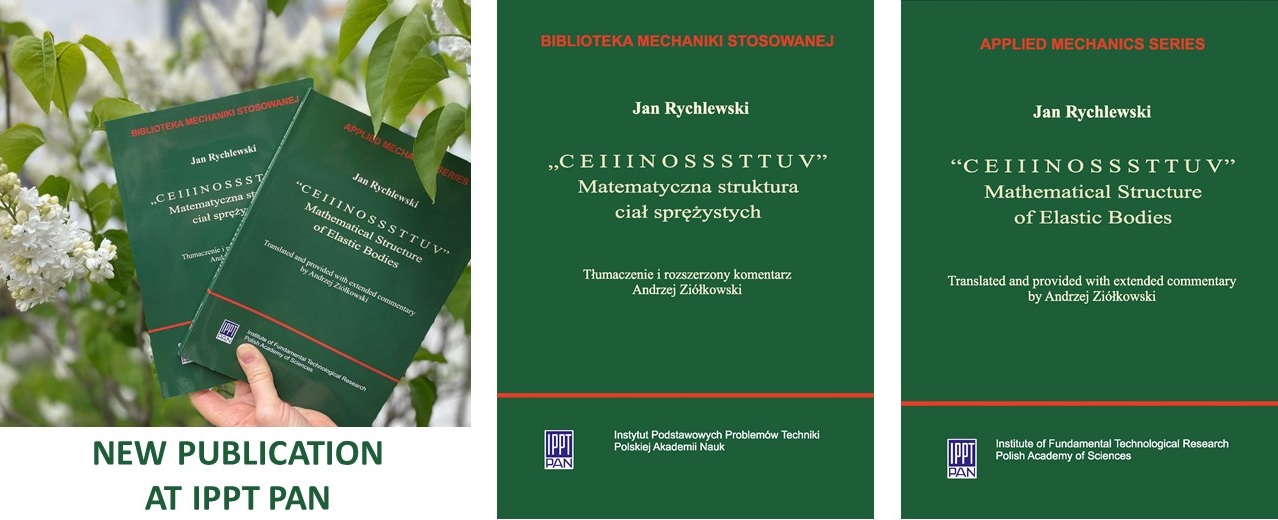The IPPT PAN has released translations of Prof. Jan Rychlewski's work titled "CEIIINOSSSTTUV: Mathematical Structure of Elastic Bodies", individually in Polish and English by Andrzej Ziółkowski, PhD Eng., who also provided extended commentary. These editions are part of the Applied Mechanics Library series.

The most common, simplest regularities are very often the most difficult to perceive and precisely formulate because they are ignored as trivial, or considered uninteresting for the same reasons. One such phenomenon is the elastic behavior of materials. The first thinker to perceive the regularity of the behavior of elastic materials, to appreciate the importance of this observation and explicitly formulate it was Robert Hooke. In 1676, he announced the publication of a rule for the behavior of elastic materials, pronouncing it in the hidden form of the Latin anagram CEIIINOSSSTTUU. Hooke deciphered this anagram two years later, in 1678, as: ut tensio, sic vis, which translates to "as the stretch, so the force".
The issue of the elastic anisotropy of materials has attracted the interest of many eminent scholars such as August Cauchy, George Green, Woldemar Voigt, and William Thomson (Lord Kelvin). However, the deepest philosophical knowledge and full understanding of the behavior of elastic anisotropic materials was not achieved until 300 years after the first formulation of Hooke's law. This was done first by Jan Rychlewski in 1983. Using internal symmetries and the spectral decomposition of the Hooke tensor, he showed that in the most general case of an anisotropic elastic material, its behavior can always be represented in terms of a maximum of six linear proportionality relations. In this way, Rychlewski showed that, given the right choice of a tensor basis, Hooke's law can be represented in an extremely simple (mathematically identical to that proposed by Hooke) uncoupled form of six linear proportionality relations. An immediate consequence of the orthogonal decomposition of the stress tensor into elastic eigenstates is the decomposition of elastic energy into six mutually independent parts, which is crucial for the formulation of strength hypotheses of strength for elastic anisotropic materials. An original parameterization of the Hooke's tensor was proposed using 21 parameters, i.e., six true elastic stiffness moduli (Kelvin moduli), 12 stiffness distributors and three Euler angles, which made it possible to introduce an extremely simple, convenient and useful systematics for dividing elastic anisotropic materials into 8 classes, which can be compared to the classical Jewgraf Fedorov's systematics of division crystallographic systems into 32 classes.
The monograph “CEIIINOSSSTTUV”. Mathematical Structure of Elastic Bodies was written during the author’s stay at the Institute of Mechanical Problems in Moscow in 1983. As emphasized by Prof. Zenon Mróz in the preface to the translation, this monograph is a groundbreaking work significantly contributing to the development of mechanics of materials. Andrzej Ziolkowski, Ph.D., translated Jan Rychlewski's work into Polish and English and enriched it with a commentary, making it more accessible to the international academic community.
“CEIIINOSSSTTUV”. Mathematical Structure of Elastic Bodies provides a fascinating perspective on the intricate anisotropic properties of elastic materials, making it a must-read for scientists, engineers, and students.
Discover the cutting-edge publication from IPPT PAN, authored by Professor Jan Rychlewski: WWW















